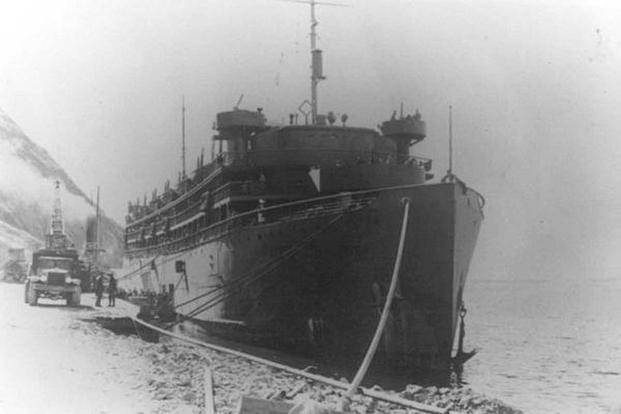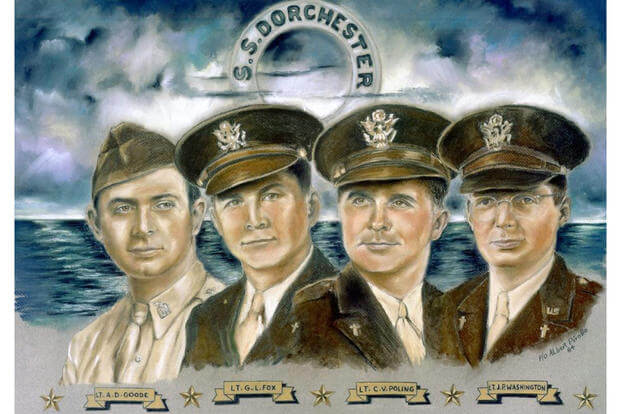Feb. 3 marks the anniversary of the sinking of the United States Army Transport Dorchester and the selfless acts of four Army chaplains aboard during World War II.
The four chaplains, also known as the "Immortal Chaplains" or the "Dorchester Chaplains," represented three faiths: Catholic, Jewish and Protestant.
The Four Chaplains Story
The 368-foot steamship Dorchester, operated by the War Shipping Administration, was part of a convoy that left New York in January 1943 bound for the Army Command Base at Narsarsuaq in southern Greenland.
To sail from Newfoundland to Greenland, the ship would have to navigate icy seas and pass through waters infested with German U-boats.
After midnight on Feb. 3, 1943, the Dorchester was torpedoed by a U-boat in the Labrador Sea off Greenland and went down in 20 minutes, according to official records.
Of the 904 aboard, 675 drowned or died of hypothermia in the frigid waters. It was believed to be the worst single death toll for a U.S. convoy during WWII.
The Dorchester's loss is remembered most for the sacrifice of the "Four Chaplains" -- two Protestants, a rabbi and a Catholic priest. They were all Army first lieutenants who went down with the ship.

The four chaplains had spent much of their time calming nervous young soldiers, even putting on evening variety shows to help pass the time.
When the torpedo hit, the chaplains guided men below decks to the lifeboats and handed out life jackets.
"Just before our ship went down, these chaplains took off their own life preservers and gave them to us," one of the survivors, 19-year-old Daniel O'Keefe of the U.S. Merchant Marine Service, said a few weeks after the tragedy. "They were standing on the deck praying hand in hand as our lifeboat drifted out of sight."
Survivor John Ladd also recalled the chaplains giving away their life vests, according to the Four Chaplains Memorial Foundation. "It was the finest thing I have seen or hope to see this side of heaven," he said.
Another survivor, William Bednar, told The Baltimore Sun in 1997: "I could hear men crying, pleading, praying and swearing. I could also hear the chaplains preaching courage to the men. Their voices were probably the only things that kept me sane."
Who Were the Four Chaplains?
The Four Chaplains were Lt. George L. Fox, a Methodist minister from Pennsylvania; Lt. Alexander D. Goode, a Reform rabbi from New York; Lt. Clark V. Poling, a Reformed Church in America minister from Ohio; and Lt. John P. Washington, a Roman Catholic priest from New Jersey.
The four became friends after they were all sent to Camp Myles Standish in Massachusetts en route to overseas duty.
Their fate was sealed when they were all assigned to the USAT Dorchester, a former luxury liner filled to capacity in February 1943 with 751 troops.
They were each posthumously awarded the Distinguished Service Cross and Purple Heart.
There were attempts in Congress to award the four chaplains the Medal of Honor, but the efforts did not succeed under the strict guidelines for awarding the medal.
Instead, a Special Medal for Heroism was authorized by Congress and awarded by President Dwight Eisenhower in 1961.
Lt. George L. Fox
As soon as he learned of the Japanese attack on Pearl Harbor in 1941, the Rev. George L. Fox knew what was to come. "I've got to go," Fox told his wife, Isadora. "I know from experience what those boys are about to face. They need me."
At age 17, the Lewistown, Pennsylvania, native had lied about his age during World War I to enlist in the Marines as a medical assistant and train as an ambulance driver.
Between the world wars, Fox finished high school, married and began his religious career.
"He later graduated from Illinois Wesleyan University in Bloomington and studied at the Boston University School of Theology, where he was ordained a Methodist minister on June 10, 1934," according to the Jewish War Veterans of the United States of America.
After the outbreak of World War II, the 42-year-old Fox immediately enlisted for chaplain duty. He began active duty on Aug. 8, 1942.
Read More: Chaplain George L. Fox
Lt. Alexander D. Goode
A native of Brooklyn, New York, Alexander Goode had been an outstanding athlete and scholar whose dream was to become a rabbi like his father, according to the U.S. Indo-Pacific Command.
He displayed heroism from a young age, saving his family's home when he was a child by extinguishing flames from a kitchen fire before firefighters arrived, according to the National Museum of the United States Army.
After high school, he received rabbinical ordination from Hebrew Union College in New York in 1937; later served at Temple Beth Israel in York, Pennsylvania; and earned his Ph.D. in Middle Eastern languages from Johns Hopkins University.
After the Pearl Harbor attack, he joined the Army Air Forces as a chaplain and later lobbied to serve on the front lines.
Goode left behind his wife, Theresa, and 3-year-old daughter, Rosalie.
"He believed that life would not be worth living in a world under Axis domination, and he was prepared to sacrifice even life itself for the cause of human freedom," Rabbi Philip S. Bernstein of the National Jewish Welfare Board said a few weeks after the chaplains were lost.
Lt. Clark V. Poling
The youngest of the four chaplains, Clark V. Poling "asked his father to pray for him when he left for the war," according to PACOM.
Poling, a seventh-generation Dutch Reformed minister, said: "Just that I shall do my duty and have the strength, courage, and understanding of men. Just pray that I shall be adequate."
Poling, who came from a long line of clergymen, was ordained to the Christian ministry in 1936 at age 26.
On the evening of the ceremony, his father, the Rev. Daniel A. Poling, told him: "I do not wish for you a life of ease nor do I desire to see you free from suffering and heartache. Rather do I desire for you a life of real conflict against the forces of evil. Be true to your calling," according to an article in The Day newspaper of New London, Connecticut.
Poling served at the First Dutch Reformed church of Schenectady, New York.
Lt. John P. Washington
John P. Washington was born to a large Irish family in New Jersey. As a child, he loved music, took piano lessons and sang in the church choir.
A graduate of Seton Hall, he later studied at Immaculate Conception Seminary in Darlington, New Jersey, before being ordained as a priest.
He served as assistant pastor of St. Stephen's Church in Kearny, New Jersey.
He joined the Army in May 1942 after the Navy rejected him due to his poor eyesight, according to the Four Chaplains Memorial Foundation.
Racing to Save Lives
When the Dorchester was going down, the Coast Guard cutter Comanche ignored the threat of another U-boat attack and raced through heavy seas to pick up survivors.
The Comanche lowered a cargo net, but many of those in the lifeboats were too weak and numbed by the cold to climb aboard.
Steward's Mate 1st Class Charles Walter David Jr., 26, of New York City, known for his fierce loyalty to his ship and shipmates despite the second-class status afforded Blacks during World War II, jumped into the lifeboats and began hoisting survivors aboard.
In the course of the rescue mission, Lt. Langford Anderson, the Comanche's executive officer, slipped and fell into the frigid waters. Without hesitation, David dove into the icy sea, swam to Anderson's rescue and brought him to the net.
After helping the last survivors scramble aboard, David went up the net himself to the Comanche's deck, but his friend, Storekeeper 1st Class Richard 'Dick" Swanson, could make it only halfway up after being in the freezing water, according to an account by William H. Thiesen, the Coast Guard's Atlantic Area historian.
From the Comanche's deck, David shouted encouragement: "C'mon, Swanny, you can make it." But Swanson couldn't move. David went down the net again and lifted Swanson to safety.
Several weeks later, David died of pneumonia at a hospital in Greenland from the hypothermia he suffered during the rescues.
"Despite his secondary status in a segregated service, Charles Walter David Jr. placed the needs of others before his own. For his heroism, David was posthumously awarded the Navy & Marine Corps Medal and, in 1999, was recognized with the Immortal Chaplains Prize for Humanity," Thiesen wrote.
In 2013, the Coast Guard named a Sentinel-class fast response cutter the Charles Walter David Jr. in honor of his exemplary service.
How to Observe Four Chaplains Day
On Feb. 3, 1951, President Harry S. Truman dedicated the Chapel of Four Chaplains in Philadelphia.
Since then, thousands of Four Chaplains interfaith memorial services are held around the nation every year, including at American Legion posts.
The American Legion's recommended guidelines for hosting a Four Chaplains memorial service include:
- Ensuring that representatives of different faith groups are invited to participate.
- Displaying photos of the four chaplains, and/or four red roses, life jackets or four empty seats near the altar or podium.
- Including a candle lighting or wreath laying.
- Including a message about selfless service.
- Collecting an offering to support the work of the Chapel of Four Chaplains.
The Four Chaplains Memorial Foundation also offers suggestions for hosting services, which go into much more detail. They include three suggested formats for memorial services: a breakfast or banquet program, a comprehensive program and a short program.
Related: WWII Chaplain Who Comforted Sailors in Shark-Infested Waters Awarded Posthumous Navy Cross
Bethanne Kelly Patrick contributed to this report.
For more military history features and resources, visit the Military.com History Center.
















